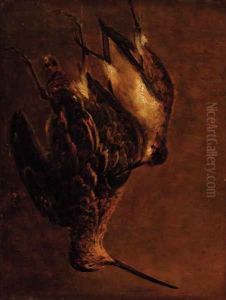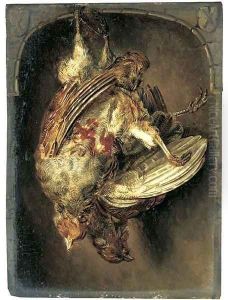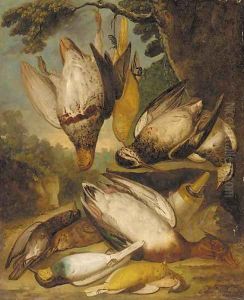William Gouw Ferguson Paintings
William Gouw Ferguson, sometimes spelled as Fergusson or Ferugson, was a Scottish painter known for his still life works, especially those featuring fruit and game. He was born in Scotland around 1632/33, though the exact location is not well documented. Ferguson's life and career spanned the 17th century, a period when still life painting was gaining popularity in Europe, particularly in the Netherlands.
Ferguson's early life and training are not thoroughly recorded, but it is believed that he left Scotland to study and work abroad, which was not uncommon for artists of his time seeking to advance their skills. By the 1650s, he had established himself in the Netherlands, where he was influenced by Dutch still life traditions, which were characterized by a meticulous attention to detail and a focus on the textures and surfaces of depicted objects.
His work often incorporated elements such as dead game, fruit, and flowers, executed with a high degree of realism. Ferguson’s paintings are noted for their subtle use of light and shadow, which added depth and realism to the compositions. He was particularly adept at rendering different materials and surfaces, from the softness of feathers to the reflective properties of metal and glass.
Despite his Scottish origins, Ferguson’s style was heavily influenced by his time in the Dutch Republic, which was a major center for still life painting. His work bears a resemblance to that of Willem van Aelst and Jan Davidsz de Heem, who were among the leading still life painters of the time. Ferguson's paintings often featured a dark background, which was typical of the Northern European still life genre and helped to highlight the subject matter.
Ferguson is thought to have traveled within Europe, with periods spent in France and Italy, though documentation of his movements is limited. His last known works were dated around the end of the 17th century, and while the precise date of his death is unknown, it is believed that William Gouw Ferguson died around 1700.
Today, Ferguson's paintings can be found in various art collections, including those of museums and galleries that specialize in Old Master paintings. However, he remains a somewhat obscure figure in art history, with much of his life and career still shrouded in mystery. Despite this, his contributions to the still life genre during the Baroque period are recognized by art historians and enthusiasts who appreciate the skill and beauty of his work.


